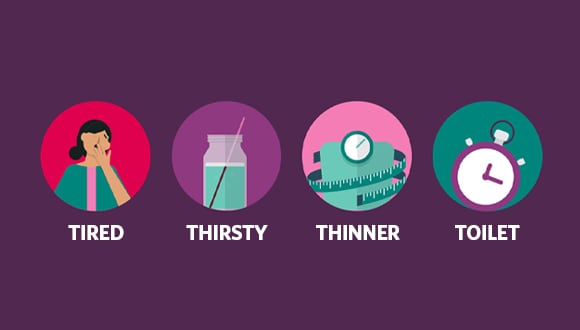Diabetes: common signs and symptoms
Updated November 2023 | 5 min read
Expert contributor Associate Professor Andrikopoulos, CEO of the Australian Diabetes Society
Words by Mariella Attard
Are you thirsty, tired and spending a lot of time in the bathroom? These could be diabetes symptoms – but there are ways to treat and live with the condition.
More than 1.5 million Australians are known to be living with all types of diabetes, which is alarmingly more than 1 in 20 Australians.
Diabetes is one of the fastest growing chronic conditions. And, as yet, there is no cure. Fortunately, there are treatments and lifestyle changes you can make to keep diabetes symptoms and the condition under control.
What is diabetes?
Diabetes is all about how your body metabolises sugar – a key part of this is the hormone insulin which is produced by your pancreas. It’s what enables glucose (from food) to enter cells and to be turned into energy.
Without insulin, you end up with high levels of glucose in the bloodstream (known as diabetic hyperglycaemia or high blood sugar) and that can eventually damage your eyes, kidneys and nerves, and may lead to heart disease and stroke.
Different types of diabetes
Type 1 diabetes occurs when the body’s immune system destroys the beta cells in your pancreas, so it produces very little or no insulin. We don’t know why that happens, and it can only be treated by replacing the absent insulin. It represents about 10% of all cases of diabetes.
With type 2 diabetes, you still have your beta cells, but either your pancreas doesn’t produce enough insulin or your body is unable to make use of it.
Gestational diabetes affects 15% of pregnant women in Australia.
What causes diabetes?
Type 1 used to be referred to as ‘juvenile diabetes’ and is one of the most common chronic childhood diseases. However, it can occur at any age and research suggests half of all cases are diagnosed over the age of 30.
We don't know what causes type 1 diabetes, but having it in the family puts you at higher risk. Other known risk factors include genetics, geography (the incidence increases as you move away from the equator) and being in the peak age brackets, which are four to seven and 10 to 14 years of age. Research is also underway into certain viruses, gut microbiome, environment and diet as contributing factors.
When it comes to type 2 diabetes, we have a much clearer understanding of the risk factors.
"Because of our lifestyles, getting type 2 diabetes has shifted from [age group] 50s and 60s to 30s and 40s," explains Associate Professor Andrikopoulos, CEO of the Australian Diabetes Society.
Gestational diabetes is caused by pregnancy hormones which can interfere with the body’s ability to make efficient use of insulin. Gestational diabetes usually resolves after the birth.
Risk factors for type 2 diabetes
Factors that may increase your chances of developing type 2 diabetes include:
- age
- family history and genetics
- unhealthy diet
- lack of physical activity
- pre-diabetes (higher than normal glucose but not high enough to cause diabetes)
- being overweight
- having had gestational diabetes.
Cultural background may also be a factor. Aboriginal and Torres Strait Islander people are three times more likely to develop type 2 diabetes than non-Indigenous Australians. And people of Pacific Islander, Maori, Asian (including the Indian sub-continent), Middle Eastern, North African or Southern European background are considered to be in a high-risk category.
Location, too, could play a part. Australians living in remote areas tend to have more risk factors and suffer double the rate of hospitalisations and deaths from diabetes compared to those in major cities.
If you want to know your potential risk of getting type 2 in the next five years, the AUSDRISK questionnaire is a good place to start. “If you score more than 12, you need to get tested,” says Assoc Prof Andrikopoulos.

Signs and symptoms of diabetes
"If you’ve got the classic signs of diabetes, then you need to see your GP," says Assoc Prof Andrikopoulos.
Those classic diabetes symptoms – known as the 4Ts – are common to both type 1 and type 2:
- tired – a level of fatigue that you can’t explain
- thirsty – you can’t drink enough to satisfy your thirst
- thinner – sudden weight loss without trying
- toilet – going to the toilet more than usual.
If you have type 1 diabetes, symptoms can come on suddenly and may include:
- having cuts that heal slowly
- itching, skin infections
- blurred vision
- mood swings
- headaches
- feeling dizzy
- leg cramps
- bed-wetting in children who didn’t do so before.
"Many times, people with type 1 diabetes are diagnosed in hospital," says Assoc Prof Andrikopoulos. "They’ll collapse with ketoacidosis (often referred to as a diabetic coma). That's quite an acute situation. We want to avoid people going to the hospital to get diagnosed."

Diabetes treatment options
Assoc Prof Andrikopoulos has been working in the field for 30 years and he says our knowledge of the disease and how to manage it has come a long way.
"You shouldn’t be worried at all," he says, reassuringly. "The advances in technology, pharmacotherapy and in our understanding of lifestyle choices and interventions are huge."
Managing any type of diabetes takes a team approach. Your first port of call is your GP. They may put you on a chronic disease management plan and can connect you with a credentialled diabetes educator who will coordinate your healthcare, arranging consultations with other specialists including a dietitian, exercise physiologist, podiatrist and ophthalmologist.
Type 1 has different treatment options to other types of diabetes. "Type 1 is an absolute deficiency of insulin, so the treatment is insulin. You’re replacing the hormone that’s not there," explains Assoc Prof Andrikopoulos.
"With type 2 there’s a relative deficiency of the hormone insulin. You still have beta cells, but they don’t produce enough. You still have some insulin, so you try and make that insulin work better. You can do that behaviourally with respect to weight loss, and you can also do it pharmacologically," says Assoc Prof Andrikopoulos.
He says the first line of therapy is putting together a lifestyle management program, and it’s critical to consider cultural and personal factors when deciding on appropriate diet and exercise that will work for the individual.
"We have the ability today to be much more person-specific in the way that we manage diabetes," he says. "It’s not a one-size-fits-all."
Health and wellbeing support
We want our members to be their healthiest selves, which is why we’ve developed a range of health and wellbeing programs to help eligible members manage their health. Our free Osteoarthritis Healthy Weight for Life program helps eligible members improve their quality of life if they’re overweight and have osteoarthritis*.
Additionally, if you or your family have diabetes or a heart-related condition, it’s never too late to start making positive changes. The COACH Program is a four to six-month phone-coaching support program provided at no extra cost for eligible members# that can help improve your heart health.
We also know losing weight and keeping it off over a long period of time can be challenging. That’s why we're offering eligible HCF members access to the evidence-based CSIRO Total Wellbeing Diet.
You can get a 20% discount on the cost of the 12 Week Program ($160 instead of $199) with eligible extras cover+ or through the HCF Thank You loyalty program**.
If you have hospital cover, are aged 18 and over, have a Body Mass Index of 28 or above, and have multiple lifestyle risk factors, you may be eligible to join the Total Wellbeing Diet Premium Plus 16 Week Program for free^^.
Related articles
Diabetes and your eye health
With an increasing number of Australians diagnosed with diabetes, poor eye health and potential vision loss is becoming an issue for more people.
Can you reverse pre-diabetes?
Lifestyle changes can reduce the risk of people with pre-diabetes developing type 2 diabetes. Find out what to do.
Living with a chronic disease
Being diagnosed with a chronic illness can be an emotional and challenging time, but your mindset can have an impact on how you cope.
What is gestational diabetes?
Despite coming with serious risks, you can manage gestational diabetes with the help of your GP and medication if you need to.
IMPORTANT INFORMATION
* Eligibility criteria applies. For more information see hcf.com.au/hwfl
# To be eligible, members must have a heart-related condition or diabetes and must have had hospital cover that includes heart conditions and vascular system for at least 12 months. Excludes Ambulance Only, Accident Only Basic cover and Overseas Visitors Health Cover. Clinical eligibility applies.
+ Must have extras cover to receive the 20% discount through eligible extras offer and must have purchased the program on or after 1 July 2023. Depending on the level of your extras cover, HCF may reimburse the cost of the 12 Week Program up to your available Health Management Program limits. Some out-of-pocket costs may apply. Excludes Overseas Visitors Health Cover.
** Eligibility criteria applies. You can access HCF Thank You offers after you’ve been a member for a week, and if your premiums are up to date. Excludes Ambulance Only and Overseas Visitors Health Cover. Offers and partners are subject to change without advance notice. See the HCF Thank You terms and conditions.
^^ Must have hospital cover, be aged 18 and over, have multiple lifestyle risk factors (eg. smoking, physical inactivity and poor nutrition) and a Body Mass Index of 28 or above. Excludes Ambulance Only, Accident Only and Overseas Visitors Health Cover.
This communication contains information which is copyright to The Hospitals Contribution Fund of Australia Ltd (HCF). It should not be copied, disclosed or distributed without the authority of HCF. Except as required by law, HCF does not represent, warrant and/or guarantee that this communication is free from errors, virus, interception or interference. All reasonable efforts have been taken to ensure the accuracy of material contained on this website. It’s not intended that this website be comprehensive or render advice. HCF members should rely on authoritative advice they seek from qualified practitioners in the health and medical fields as the information provided on this website is general information only and may not be suitable to individual circumstances or health needs. Please check with your health professional before making any dietary, medical or other health decisions as a result of reading this website.